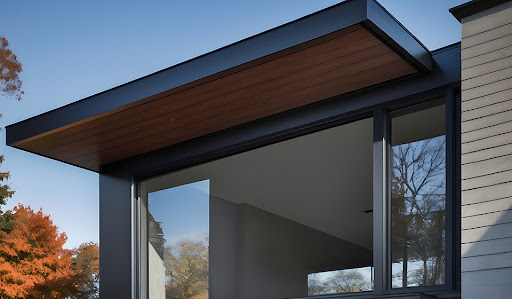Aluminium coping, also known as aluminium caps or wall coping, is installed on top of parapet walls and other raised edges of buildings. Aluminium coping serves both aesthetic and functional purposes – it provides an attractive finish for the tops of walls while also protecting the underlying structure from water damage. In recent years, aluminium coping has emerged as a highly popular choice for contemporary design due to its many advantages over alternative materials.
What Is Aluminium Wall Coping Used For?
The primary function of aluminium wall coping is to prevent rainwater and moisture from seeping into the wall and causing leaks or structural damage. The coping caps the top of the wall and overhangs the edges slightly, allowing water to drip over the outer side of the building. This protects the core of the parapet wall from getting saturated. Additionally, quality aluminium coping is designed with drips or ribs on the underside that interrupt the flow of water while preventing any potential infiltration into the wall.
Aluminium coping also serves an aesthetic purpose with its sleek, modern look. It provides an attractive finish for the tops of walls and balustrades, concealing messy brickwork edges and giving the structure’s peripheries a streamlined appearance. The coping can be powder coated in a wide range of colours, allowing it to match or complement the overall colour scheme of the building’s exterior. This makes it a popular choice to enhance the architectural appeal of modern homes and buildings.
Why Aluminium Coping Takes the Lead in Modern Design
There are several key reasons why aluminium is the preferred material for parapet walls and edging applications:
Durability That Lasts for Decades
High-grade aluminium coping that contains alloys like 6063-T5 boasts exceptional corrosion and oxidation resistance. While cheaper aluminium can degrade within just a few years, quality aluminium coping holds up beautifully even after decades of exposure to weather elements like rain, snow, UV rays, and more. This coping requires little maintenance while maintaining its eye-catching appearance for longer.
Flexibility and Strength Combined
Quality extruded aluminium coping offers the perfect blend of malleability and strength. Its flexible nature allows pieces to be bent and shaped as needed during coping installation. This enables customised solutions for corners, curves, and other unique structural features. At the same time, aluminium coping provides ample strength to protect walls from damage while retaining their formed shape without warping or cracking over time.
Lighter Weight Than Many Alternatives
Compared to concrete, stone, and even steel coping, aluminium weighs much less per linear foot. This equates to easier transport and installation. The lightweight nature also puts less pressure and stress on the walls and structures. Whether gracing a commercial building or residential home, aluminium’s lighter coping profile makes it easier for construction teams to handle while offering plenty of protective power.
Sleek, Modern Aesthetic Appeal
Clean lines, subtle sheens, and custom colour availability make aluminium coping visually attractive for design integration. Compared to rustic wood or rough concrete coping, aluminium offers a more refined, contemporary look aligned with modern architectural aesthetics. Designers can select from several available finish options, including powder-coated, and anodised aluminium coping pieces. This allows further customisation to perfectly match associated structures.
Cost Competitiveness and Value Compared to Other Metals
Compared to stainless steel and copper alternatives, aluminium is affordable and still delivers superior durability and weather resistance. Moreover, this reasonably priced non-ferrous metal delivers excellent value thanks to aluminium’s impressive longevity. With the added benefit of being lightweight, aluminium coping not only saves on labour but also requires minimal maintenance, making it a sensible and economical choice.
How to Install Coping with Precision and Expertise
A smooth installation is crucial for unlocking aluminium coping and capping’s full advantages. Here are the steps for the aluminium coping installation.
- Prepare the Solid Foundation for Coping Installation
- Measuring and Cutting Coping for Seamless Fit
- Securely Anchoring Coping for Long-lasting Stability
- Finalising Your Coping Installation with Finishing Touches
How Long Should Aluminium Wall Coping Last?
When professionally fabricated and installed, high-grade aluminium coping should provide a minimum service life of 40 to 50 years. However, it’s not uncommon for commercial and residential aluminium coping to last considerably longer—often over 60 years—without the need for replacement.
The long-lasting durability of aluminium coping is attributable to the inherent properties of aluminium itself. Aluminium offers exceptional resistance to corrosion, whereas many other metals rapidly degrade when exposed to the elements. Even after decades of exposure to harsh weather, aluminium retains its intact, stable molecular structure. It won’t easily crack, peel, flake, or crumble over extended timeframes like cheaper steels and irons.
Additionally, the powder-coated finish applied to most aluminium coping adds further weather-proofing and longevity. A quality polyester powder coating creates a durable, fade-resistant and scruff-resistant barrier that shields the aluminium from the worst impacts of the sun, salt, and storms. This preserves the aesthetic good-looks of the coping far longer than other exterior finishes like paint and anodising.
Provided the aluminium is of marine-grade quality with an appropriate thickness and a high-quality powder coating, the coping should endure for half a century or more. This represents outstanding product life at a very reasonable price point. Most alternative options can’t match the exceptional combination of strong performance, low maintenance, and attractive value that aluminium coping has delivered for decades
The Bottom Line
With corrosion resistance, strength, aesthetics, and cost-efficiency all wrapped into one package, aluminium reigns as a top coping choice for homes and business settings. Architects, contractors, and homeowners seeking to optimise the advantages of quality coping consistently opt for the enduring properties of aluminium. When appropriately selected using ideal alloys, tempers, thicknesses, and fabrication, aluminium coping maintains structural and aesthetic integrity for a long time, even in harsh seaside and industrial settings. Compared to competing coping materials, aluminium’s well-rounded characteristics elevate it to broad modern appeal across residential, commercial, and institutional projects alike.
